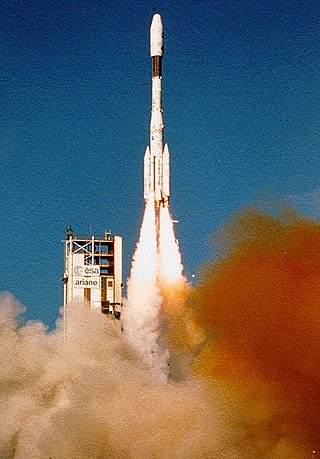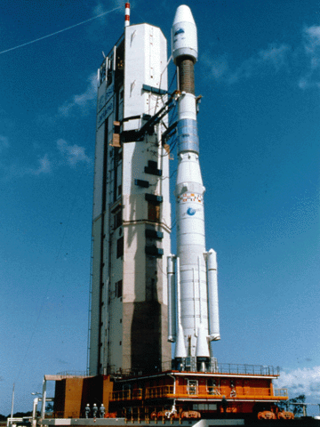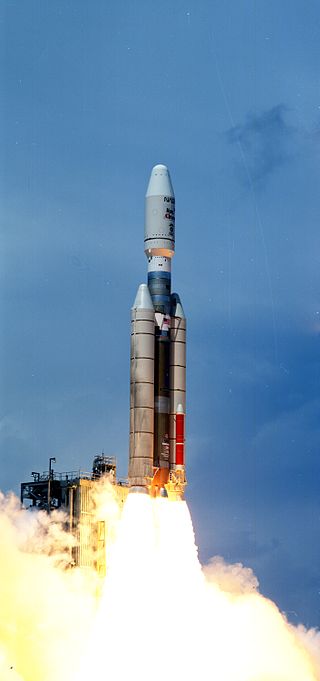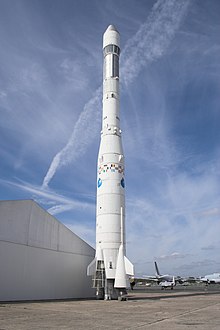
Ariane 5 is a retired European heavy-lift space launch vehicle developed and operated by Arianespace for the European Space Agency (ESA). It was launched from the Centre Spatial Guyanais (CSG) in French Guiana. It was used to deliver payloads into geostationary transfer orbit (GTO), low Earth orbit (LEO) or further into space. The launch vehicle had a streak of 82 consecutive successful launches between 9 April 2003 and 12 December 2017. Since 2014, Ariane 6, a direct successor system, is in development.

Arianespace SA is a French company founded in 1980 as the world's first commercial launch service provider. It undertakes the operation and marketing of the Ariane programme. The company offers a number of different launch vehicles: the heavy-lift Ariane 6 for dual launches to geostationary transfer orbit, and the solid-fueled Vega series for lighter payloads.

Ariane is a series of European civilian expendable launch vehicles for space launch use. The name comes from the French spelling of the mythological character Ariadne. France first proposed the Ariane project and it was officially agreed upon at the end of 1973 after discussions between France, Germany and the UK. The project was Western Europe's second attempt at developing its own launcher following the unsuccessful Europa project. The Ariane project was code-named L3S.

The Ariane 4 was a European expendable launch vehicle, developed by the Centre national d'études spatiales (CNES), the French space agency, for the European Space Agency (ESA). It was manufactured by ArianeGroup and marketed by Arianespace. Since its first flight on 15 June 1988 until the final flight on 15 February 2003, it attained 113 successful launches out of 116 total launches.

The Europa rocket was an early expendable launch system of the European Launcher Development Organisation (ELDO), which was the precursor to the European Space Agency (ESA). It was developed with the aim to delivering space access technology, and more specifically to facilitate the deployment of European-wide telecommunication and meteorological satellites into orbit.

The Diamant rocket was the first exclusively French expendable launch system and at the same time the first satellite launcher not built by either the United States or USSR. As such, it has been referred to as being a key predecessor for all subsequent European launcher projects.

Ariane 3 was a European expendable carrier rocket, which was used for eleven launches between 1984 and 1989. It was a member of the Ariane family of rockets. The principal manufacturer for the Ariane 3 was Aérospatiale, while the lead agency for its development was the Centre National d'Etudes Spatiales (CNES).
Ariane 2 was a European expendable space launch vehicle, operated by the European Space Agency (ESA) between 1986 and 1989 as part of Ariane family of rockets. The principal manufacturer for the Ariane 2 was Aérospatiale, while the lead agency for its development was the Centre National d'Etudes Spatiales (CNES), the French government's space agency.

The Guiana Space Centre, also called Europe's Spaceport, is a European spaceport to the northwest of Kourou in French Guiana, a region of France in South America. Kourou is located approximately 310 mi (500 km) north of the equator at a latitude of 5°. In operation since 1968, it is a suitable location for a spaceport because of its equatorial location and open sea to the east.

The Automated Transfer Vehicle, originally Ariane Transfer Vehicle or ATV, was an expendable cargo spacecraft developed by the European Space Agency (ESA), used for space cargo transport in 2008–2015. The ATV design was launched to orbit five times, exclusively by the Ariane 5 heavy-lift launch vehicle. It effectively was a larger European counterpart to the Russian Progress cargo spacecraft for carrying upmass to a single destination—the International Space Station (ISS)—but with three times the capacity.

Vega is an expendable launch system in use by Arianespace jointly developed by the Italian Space Agency (ASI) and the European Space Agency (ESA). Development began in 1998 and the first launch took place from the Guiana Space Centre on 13 February 2012.

Black Arrow, officially capitalised BLACK ARROW, was a British satellite expendable launch system.

This is a timeline of first orbital launches by country. While a number of countries, incl. Canada, Australia, Germany, Brazil, Algeria, Kazakhstan, Turkey, Argentina, Italy, Malaysia, Poland, South Africa, the Philippines, Egypt, Spain, Mexico, Thailand and Chile, have built or launched satellites, as of 2022, eleven countries, incl. the United States, Japan, China, India, Iran, Israel, France, the United Kingdom and South Korea, have had the capability to send objects into orbit with their own launch vehicles. Russia and Ukraine inherited the capability of the space launchers and satellites from the Soviet Union, following its dissolution in 1991. Russia launches its rockets from its own and foreign (Kazakh) spaceports.

ELA-3, is a launch pad and associated facilities at the Centre Spatial Guyanais in French Guiana. ELA-3 was operated by Arianespace as part of the expendable launch system for Ariane 5 launch vehicles. As of July 2023, 117 launches have been carried out from it, the first of which occurred on 4 June 1996. The final launch occurred on 5 July 2023.
The Intelsat VI series of satellites were the 8th generation of geostationary communications satellites for the Intelsat Corporation. Designed and built by Hughes Aircraft Company (HAC) in 1983-1991, there were five VI-series satellites built: 601, 602, 603, 604, and 605.

The Commercial Titan III, also known as CT-3 or CT-III, was an American expendable launch system, developed by Martin Marietta during the late 1980s and flown four times during the early 1990s. It was derived from the Titan 34D, and was originally proposed as a medium-lift expendable launch system for the US Air Force, who selected the Delta II instead. Development was continued as a commercial launch system, and the first rocket flew in 1990. Due to higher costs than contemporary rockets such as the Ariane 4, orders were not forthcoming, and the CT-3 was retired in 1992.

Ariane 6 is a European expendable launch system developed by ArianeGroup on behalf of the European Space Agency (ESA). It replaces the Ariane 5, as part of the Ariane launch vehicle family. The stated motivation for Ariane 6 was to halve the cost compared to Ariane 5, and increase the capacity for the number of launches per year.
Space launch market competition is the manifestation of market forces in the launch service provider business. In particular it is the trend of competitive dynamics among payload transport capabilities at diverse prices having a greater influence on launch purchasing than the traditional political considerations of country of manufacture or the national entity using, regulating or licensing the launch service.

ArianeGroup is an aerospace company based in France. A joint venture between Airbus and Safran, the company was founded in 2015 and is headquartered in Issy-les-Moulineaux near Paris. It consists of three core groups: aerospace, defence and security. ArianeGroup has developed its next-generation two-stage Ariane 6 launch vehicle, which succeeded the Ariane 5 rocket, that had more than 110 launches. The new vehicle offers two variants that will be capable of carrying between 10,350 and 21,650 kilograms. The first launch of Ariane 6 is expected to occur in 2024.

















